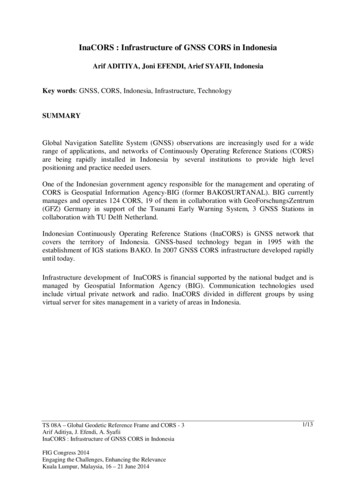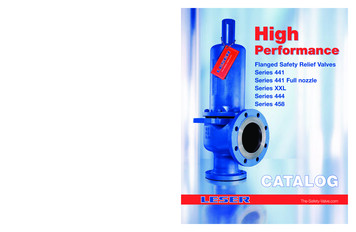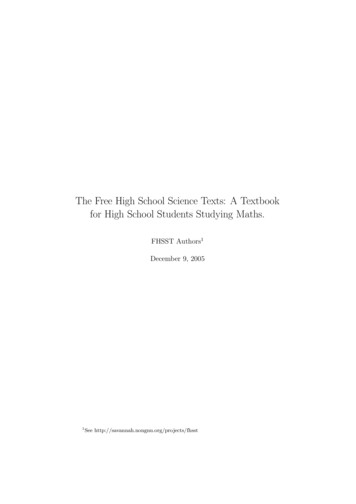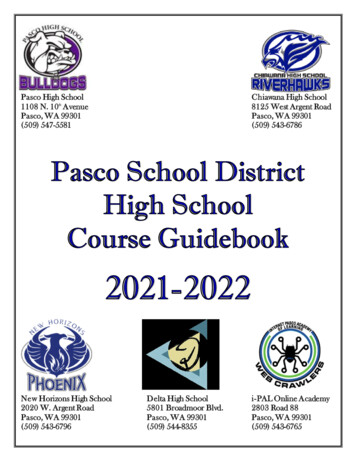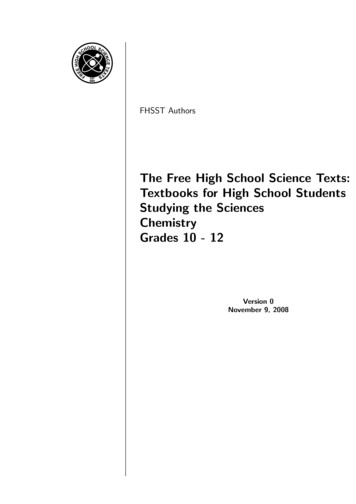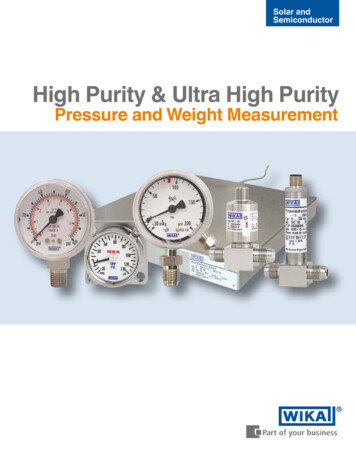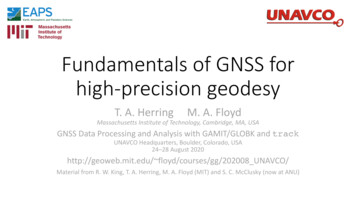
Transcription
Fundamentals of GNSS forhigh-precision geodesyT. A. HerringM. A. FloydMassachusetts Institute of Technology, Cambridge, MA, USAGNSS Data Processing and Analysis with GAMIT/GLOBK and trackUNAVCO Headquarters, Boulder, Colorado, USA24–28 August 2020http://geoweb.mit.edu/ floyd/courses/gg/202008 UNAVCO/Material from R. W. King, T. A. Herring, M. A. Floyd (MIT) and S. C. McClusky (now at ANU)
Outline GNSS Observables: GNSS data and the combinations of phase and pseudo-range used Modeling the observations: Aspects not well modeled Multipath and antenna phase center models Atmospheric delay propagation Limits of GNSS accuracy Monument types Loading (more later) Orbit quality2020/08/24Fundamentals of GNSS for geodesy1
Instantaneous positioning with GNSS pseudorangesReceiver solution, teqc qc or sh rx2apr Point position (svsp3): 5–100 m Differential (svsp3): 1–10 mYour location is:37o 23.323’ N122o 02.162’ W2020/08/24Fundamentals of GNSS for geodesy2
Precise positioning using phasemeasurements25000000 Long-session static: tracking of changein phase over time carries most of theinformation24000000 The shorter the span the moreimportant is ambiguity resolutionRange (m) High-precision positioning uses thephase observations2300000022000000C1 07 (m)Theory (m)C1 28 (m)Theory (m)C1 26 (m)Theory (m)C1 11 (m)Theory (m)C1 02 (m)Theory (m)21000000Each satellite (and station)has a different signature2020/08/242000000016.017.0Fundamentals of GNSS for geodesy18.019.020.0Time Hrs21.022.023.024.03
Observables in data processing Fundamental observations L1 phase f1 range (λ 19 cm) L2 phase f2 range (λ 24 cm) C1 or P1 pseudorange used separately to get receiver clock offset (time) To estimate parameters use doubly-differenced observables LC 2.55 L1 1.98 L2 “ionosphere-free phase combination” (L1 cycles) PC 2.55 P1 1.55 P2 “ionosphere-free range combination” (meters) Double differencing (DD) cancels clock fluctuations; LC cancels almost all of ionosphere. Both DDand LC amplify noise (use L1 and L2 directly and independently for baselines 1 km) Auxiliary combinations for data editing and ambiguity resolution:“geometry-free combination (LG)” or “extra wide-lane” (EX-WL) LG L2 f2/f1 L1(used in GAMIT) EX-WL L1 f1/f2 L2 (used in track) Removes all frequency-independent effects (geometric & atmosphere) but not multipath or ionosphere Melbourne-Wubbena wide-lane (MW-WL): phase/pseudorange combination thatremoves geometry and ionosphere; dominated by pseudorange noise MW-WL N1 N2 (L1 L2) (Df/Sf)(P1 P2) (L1 L2) 0.12(P1 P2) With GNSS processing, other frequencies are available (and changing with time).2020/08/24Fundamentals of GNSS for geodesy4
Modeling the observationsI. Conceptual/Quantitative Motion of the satellites Earth’s gravity field (flattening effect approx. 10 km; higher harmonics 100 m) Attraction of Moon and Sun (100 m ) Solar radiation pressure (20 m): Different for different GNSS types Motion of the Earth Irregular rotation of the Earth (5 m) Luni-solar solid-Earth tides (30 cm) Loading due to the oceans, atmosphere, and surface water and ice (10 mm) Propagation of the signal Neutral atmosphere (dry 6 m; wet 1 m) Ionosphere (10 m but LC corrects to a few mm most of the time) Variations in the phase centers of the ground and satellite antennas (10 cm)* incompletely modeled2020/08/24Fundamentals of GNSS for geodesy5
Modeling the observationsII. Software structure Satellite orbit IGS tabulated ephemeris (Earth-fixed SP3 file) [track] GAMIT tabulated ephemeris (t-file): numerical integration by arc in inertial space, fit to SP3file, may be represented by its initial conditions (ICs) and radiation-pressure parameters;requires tabulated positions of Sun and Moon Motion of the Earth in inertial space [model or track] Analytical models for precession and nutation (tabulated); IERS observed values for poleposition (wobble), and axial rotation (UT1) Analytical model of solid-Earth tides; global grids of ocean and atmospheric tidal loading Propagation of the signal [model or track] Zenith hydrostatic (dry) delay (ZHD) from pressure (met-file, VMF1, or GPT)Zenith wet delay (ZWD) [crudely modeled and estimated in solve or track]ZHD and ZWD mapped to line-of-sight with mapping functions (VMF1 grid or GMF)Variations in the phase centers of the ground and satellite antennas (ANTEX file)2020/08/24Fundamentals of GNSS for geodesy6
Parameter estimation Phase observations [solve or track]Form double difference LC combination of L1 and L2 to cancel clocks & ionosphereApply a priori constraintsEstimate the coordinates, ZTD, and real-valued ambiguitiesForm M-W WL and/or phase WL with ionospheric constraints to estimate andresolve the WL (N2 N1) integer ambiguities [autcln (or solve), track] Estimate and resolve the narrow-lane (NL) ambiguities [solve, track] Estimate the coordinates and ZTD with WL and NL ambiguities fixed Estimation can be batch least squares [solve] or sequential (Kalman filter) [track] Quasi-observations from phase solution (h-file) [globk] Sequential (Kalman filter) Epoch-by-epoch test of compatibility (χ2 increment) but batch output2020/08/24Fundamentals of GNSS for geodesy7
Limits of GNSS accuracy Signal propagation effects Signal scattering ( antenna phase center / multipath )Atmospheric delay (mainly water vapor)Ionospheric effectsReceiver noise Unmodeled motions of the station Monument instability Loading of the crust by atmosphere, oceans, and surface water Unmodeled motions of the satellites Reference frame2020/08/24Fundamentals of GNSS for geodesy8
Limits of GNSS accuracy Signal propagation effects Signal scattering (antenna phase center / multipath)Atmospheric delay (mainly water vapor)Ionospheric effectsReceiver noise Unmodeled motions of the station Monument instability Loading of the crust by atmosphere, oceans, and surface water Unmodeled motions of the satellites Reference frame2020/08/24Fundamentals of GNSS for geodesy9
Multipath is interference between the direct and afar-field reflected signal (geometric optics apply)To mitigate the effects: Avoid reflective surfaces Use a ground plane antennaD2020/08/24Fundamentals of GNSS for geodesyalngSitcirenal Remove with average from many dayslRefalSig Observe for many hoursignSdecteReflected Avoid near-ground mounts10
Antenna height0.15 m0.6 m1mSimple geometry for incidenceof a direct and reflected signalMultipath contributions to observed phase for threedifferent antenna heights (from Elosegui et al., 1995)2020/08/24Fundamentals of GNSS for geodesy11
More dangerous are near-fieldsignal interactions that change theeffective antenna phase center withthe elevation and azimuth of theincoming signalAntenna phase patternsRight: Examples of the antenna phasepatterns determined in an anechoicchamber BUT the actual pattern in the fieldis affected by the antenna mountTo avoid height and ZTD errors ofcentimeters, we must use at least a nominalmodel for the phase-center variations (PCVs)for each antenna typeFigures courtesy of UNAVCO2020/08/24Fundamentals of GNSS for geodesy12
Atmospheric delayThe signal from each GNSS satellite is delayed by an amount dependent on the pressure and humidityand its elevation above the horizon. We invert the measurements to estimate the average delay at thezenith (green bar).(Figure courtesy of COSMIC Program)2020/08/24Fundamentals of GNSS for geodesy13
Zenith delay from wet and dry componentsof the atmosphere Colors are for different satellites Total delay is 2.5 meters Variability mostly caused by wetcomponent Wet delay is 0.2 meters Obtained by subtracting thehydrostatic (dry) delay Hydrostatic delay is 2.2 metersPlot courtesy of J. Braun, UCAR2020/08/24 Little variability between satellites orover time Well calibrated by surface pressureFundamentals of GNSS for geodesy14
Multipath and water vapor effectsin the observationsOne-way (undifferenced) LC phase residuals projected onto the sky in 4-hr snapshots. Spatially repeatablenoise is multipath; time-varying noise is water vapor.Red is satellite track.Red bar is scale (10 mm).2020/08/24(positive) and green (negative) residuals purely for visual effect.Fundamentals of GNSS for geodesy15
Limits of GNSS accuracy Signal propagation effects Signal scattering (antenna phase center / multipath)Atmospheric delay (mainly water vapor)Ionospheric effectsReceiver noise Unmodeled motions of the station Monument instability Loading of the crust by atmosphere, oceans, and surface water Unmodeled motions of the satellites Reference frame2020/08/24Fundamentals of GNSS for geodesy16
Monuments anchored to bedrock are critical for tectonic studies(not so much for atmospheric studies)Good anchoring: Pin in solid rock Drill-braced (left) in fractured rock Low building with deep foundationNot-so-good anchoring: Vertical rods Buildings with shallow foundation Towers or tall building (thermaleffects)2020/08/24Fundamentals of GNSS for geodesy17
Annual component of vertical loadingAtmosphere (purple)2-5 mmWater/snow (blue/green)2-10 mmNontidal ocean (red)2-3 mmFrom Dong et al. J. Geophys. Res., 107, 2075, 20022020/08/24Fundamentals of GNSS for geodesy18
Limits of GNSS accuracy Signal propagation effects Signal scattering (antenna phase center / multipath)Atmospheric delay (mainly water vapor)Ionospheric effectsReceiver noise Unmodeled motions of the station Monument instability Loading of the crust by atmosphere, oceans, and surface water Unmodeled motions of the satellites Reference frame2020/08/24Fundamentals of GNSS for geodesy19
GPS SatelliteLimits to model are nongravitational accelerations dueto solar and Earth radiation,unbalanced thrusts, andoutgassing; and non-sphericalantenna patternModeling of these effects hasimproved, but for globalanalyses remain a problemParametric models are used inGAMIT and these evolve withtime (and version)2020/08/24Fundamentals of GNSS for geodesy20
Quality of IGS Final Orbits1994-2020/0820 mm 1 ppb(http://www.igs.org/analysis/gps-final)Analysis centers now 15 mm RMS difference2000/1/1 Week 10422020/08/24Fundamentals of GNSS for geodesy21
Quality of IGS FinalOrbits 2019/08-2020/0820 mm 1 08/24Fundamentals of GNSS for geodesyAnalysis centers now 10 mm RMSdifference.Brown line is MITGAMIT showing impactof SRP modelimprovements inversion 10.7122
Limits of GNSS accuracy Signal propagation effects Signal scattering (antenna phase center / multipath)Atmospheric delay (mainly water vapor)Ionospheric effectsReceiver noise Unmodeled motions of the station Monument instability Loading of the crust by atmosphere, oceans, and surface water Unmodeled motions of the satellites Reference frame2020/08/24Fundamentals of GNSS for geodesy23
Reference frames Basic Issue: How well can you relateyour position estimates over time to:1. A set of stations whose motion is wellmodeled?2. A block of crust that allows you tointerpret the motions? Implementation: How to use theavailable data and the features ofGLOBK to realize the frame(s) Both questions to be addressed indetail in later lectures2020/08/24Fundamentals of GNSS for geodesy24
Effect of Orbital and Geocentric Position Error(Uncertainty) High-precision GNSS is essentially relative! Baseline error (uncertainty) Baseline length geocentric SV or position errorSV altitude SV errors reduced by averaging: Baseline errors are 0.2 orbital error/20,000 km e.g. 20 mm orbital error 1 ppb or 1 mm on 1000 km baseline Network (“absolute”) position errors less important for small networks e.g. 5 mm position error 1 ppb or 1 mm on 1000 km baseline 10 cm position error 20 ppb or 1 mm on 50 km baseline But SV and position errors are magnified for short sessions2020/08/24Fundamentals of GNSS for geodesy25
Summary GNSS observables GNSS data and the combinations of phase and pseudo-range used Modeling the observations: Aspects not well modeled are Multipath and antenna phase center models Atmospheric delay propagation Limits of GNSS accuracy Monument types Loading (more later) Orbit quality: Since 2000 less than 40 mm, corresponding to 2 ppb Hard to improve on the IGS orbits2020/08/24Fundamentals of GNSS for geodesy26
Fundamentals of GNSS for high-precision geodesy T. A. Herring M. A. Floyd Massachusetts Institute of Technology, Cambridge, MA, USA GNSS Data Processing and Analysis with GAMIT/GLOBK and track
